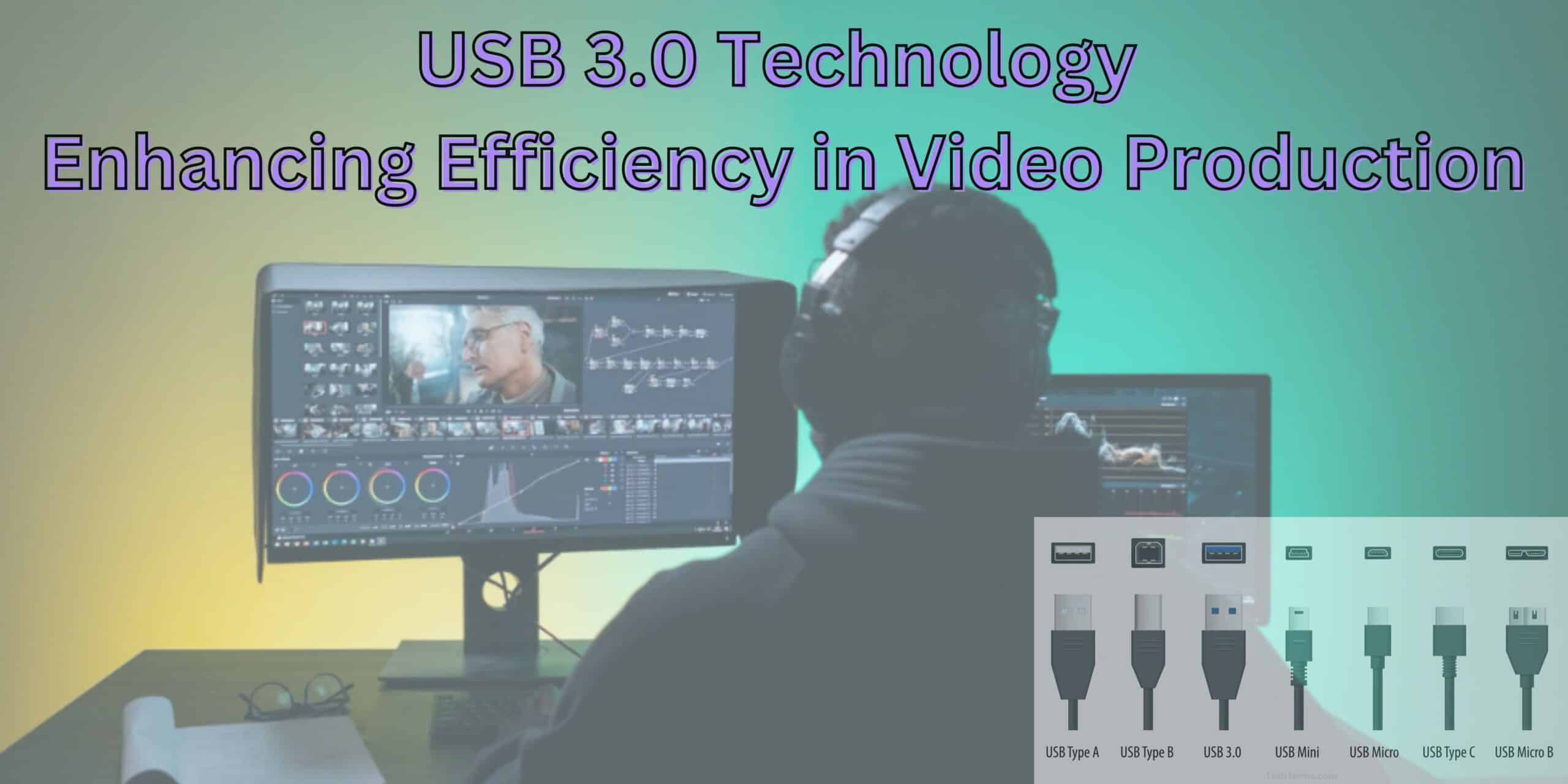USB 3.0 Technology Enhancing Efficiency in Video Production

Introduction:
In the fast-paced world of video production, efficiency is key. With an increasing reliance on digital technology, managing large video files quickly and efficiently has become a top priority for production teams. High-speed USB 3.0 Technology drives have emerged as essential tools in this environment, offering the necessary speed and reliability for handling large video files with ease. This technology not only enhances data transfer speeds but also streamlines workflows, significantly improving overall productivity and reducing bottlenecks.
Section 1: Challenges in Video Production Data Management
Video production involves the creation of massive files, especially in high-definition (HD) and 4K formats. These large video files can strain even the most capable systems if not managed properly.
The challenges in video production data management include:
- Growing File Sizes: With the rise of higher resolution videos and multi-camera setups, file sizes have grown substantially. A single minute of 4K footage can easily exceed 1GB, requiring faster data handling capabilities to keep up with the demands of modern production.
- Slow External Drives and Outdated Technology: Many production teams rely on external hard drives or older USB 3.0 Technology (USB 2.0 or earlier), which can be too slow for the demands of video production. Transferring large video files can take a significant amount of time, delaying critical production processes.
- Data Transfer Bottlenecks: When transferring footage between computers, servers, and external drives, slow data transfer speeds can create bottlenecks that impede productivity. This results in wasted time, missed deadlines, and disruptions in the workflow.
Section 2: How USB 3.0 Drives Enhance the Video Production Workflow
USB 3.0 technology offers several key advantages that directly address the challenges of managing large video files:
- Faster Transfer Speeds: USB 3.0 Technology provides a substantial improvement over its predecessors (USB 2.0 and earlier versions), with transfer speeds of up to 5Gbps. This means that video production teams can transfer large files — such as raw footage, edits, and effects — much more quickly, reducing downtime and keeping the production on schedule.
- Reduced Wait Time: With USB 3.0 Technology drives, the time spent waiting for files to move between systems is drastically reduced. This quick transfer ability helps video production teams stay focused and efficient, allowing them to move on to the next task without delays.
- Managing Raw Footage and Edits: USB 3.0 Technology drives are essential for storing raw footage, video edits, and backup copies. Their high-speed capabilities allow video editors to work with these files seamlessly, streamlining the editing process and enabling real-time previews without lag.
Section 3: Real-Life Case Study: Video Production Team Adopts USB 3.0 Drives
A leading video production company, specializing in creating high-quality commercial videos, recently integrated high-speed USB 3.0 Technology drives into its workflow. Prior to this, the team relied on traditional external hard drives, which led to significant delays during the editing process. Transferring 4K footage between devices took far too long, leading to unnecessary downtime and bottlenecks in post-production.
After adopting USB 3.0 drives, the team noticed a remarkable difference in efficiency:
- Faster Project Completion: With quicker file transfers, editors were able to complete projects faster, meeting tight deadlines with ease. The time saved on data transfers allowed for more time spent on creative work, such as refining edits and adding special effects.
- Reduced Downtime: USB 3.0 drives minimized the downtime previously associated with waiting for files to transfer. Instead of staring at loading screens, production teams could focus on actual editing work, making the entire process more productive.
- Improved Team Collaboration: Because of the faster transfer speeds, the video production team was able to collaborate more effectively. Team members could share files more easily and work simultaneously, leading to smoother coordination and better output.
Section 4: Other Benefits of USB 3.0 for Video Production
Beyond faster data transfer speeds, USB 3.0 drives offer other benefits that are particularly important in the world of video production:
- Portability: USB 3.0 drives are compact and lightweight, making them easy to transport. For on-the-go production teams, especially those working on location shoots or remote editing setups, the portability of these drives ensures that all project files are accessible at any time.
- Durability: Video production often requires outdoor shoots or work in challenging environments. USB 3.0 drives are generally designed to be more durable and resistant to physical wear and tear, making them ideal for the rough conditions that can come with location shoots.
- Wide Compatibility: USB 3.0 drives are compatible with a wide range of video production hardware and software, ensuring that they integrate smoothly into existing production workflows. Whether it’s a laptop, desktop, or editing software, USB 3.0 drives offer universal support for various systems.
USB 3.0 technology
USB 3.0 technology has significantly improved efficiency in video production by offering faster data transfer speeds, reduced latency, and better power management. Here’s how it enhances workflow in video production:
1. Faster Data Transfer Speeds
One of the most significant advantages of USB 3.0 is its high-speed data transfer rate of up to 5 Gbps, which is 10 times faster than USB 2.0 (480 Mbps). This improvement drastically reduces the time needed to copy or move large video files, especially when working with high-resolution formats such as 4K, 6K, and 8K RAW footage.
For example, transferring a 10GB video file using:
- USB 2.0: Approximately 3–4 minutes
- USB 3.0: Approximately 15–20 seconds
This speed advantage is essential for professionals who need quick turnaround times for editing, rendering, and post-production.
2. Seamless External Storage and Editing
Many video professionals use external hard drives or SSDs for editing. USB 3.0 provides the necessary bandwidth for real-time editing directly from external drives without lag, ensuring a smooth workflow.
Professional video editors often use external SSDs and hard drives for storage due to the massive file sizes involved. With USB 3.0’s enhanced bandwidth, editors can directly edit high-resolution videos from an external drive without needing to transfer files to their computer’s internal storage.
This is especially beneficial for:
- Mobile editors who work on the go.
- Collaborative projects, where multiple editors access files from shared drives.
- Backup and redundancy workflows, ensuring data security while maintaining editing speed.
With an external SSD connected via USB 3.0, users can achieve read/write speeds of up to 400–500 MB/s, compared to 30–40 MB/s with a USB 2.0 connection, making real-time editing much smoother.
3. High-Resolution Video Capture
USB 3.0 allows for real-time, uncompressed video capture from cameras and capture cards, which is crucial for live streaming and professional video production setups.
4. Reduced Latency for Peripherals
Devices like external monitors, audio interfaces, and video capture cards benefit from the low-latency performance of USB 3.0, leading to smoother playback and better synchronization.
5. Improved Power Delivery
USB 3.0 provides up to 900mA of power (compared to 500mA in USB 2.0), allowing for bus-powered external devices, reducing the need for additional power sources.
6. Compatibility and Future-Proofing
While USB 3.0 is backward compatible with USB 2.0 devices, it also paves the way for future upgrades to USB 3.1 and USB-C technology, making it a solid investment for video production setups.
Conclusion:
In summary, the integration of high-speed USB 3.0 drives into video production workflows has proven to be a game-changer. The faster data transfer speeds, increased portability, and improved compatibility of USB 3.0 drives help streamline the video production process, making it easier to manage large video files efficiently. By reducing bottlenecks, minimizing downtime, and enabling better collaboration among team members, USB 3.0 drives significantly improve productivity and workflow.
For video production teams looking to optimize their processes and meet tight deadlines, investing in USB 3.0 drives is a smart move. With the ability to handle large video files with speed and reliability, these drives are essential tools for modern video production. By incorporating USB 3.0 technology, production teams can stay ahead of the competition, ensuring that projects are completed on time and to the highest quality standards.









